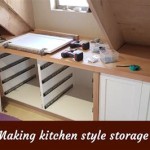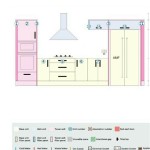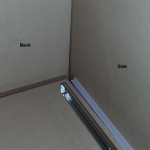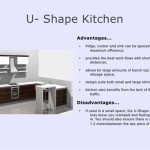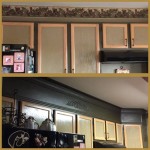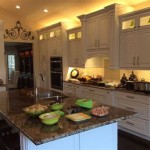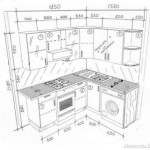How Much Space Between Kitchen Shelves
Optimizing kitchen storage is a crucial aspect of creating a functional and efficient cooking space. Shelf spacing plays a significant role in maximizing storage capacity and ensuring easy access to items. Determining the ideal distance between shelves requires careful consideration of the items to be stored and the overall kitchen design.
A common mistake in kitchen design is uniform shelf spacing. While aesthetically pleasing, this approach often leads to wasted space. A more practical approach involves varying the vertical distance between shelves based on the height of commonly used items. This customized approach allows for better utilization of the vertical space within cabinets.
For storing small items like spices, cans, and jars, shelves spaced 6 to 8 inches apart are typically sufficient. This spacing prevents stacking, which can make items difficult to access and potentially lead to spills. Adjustable shelving is particularly beneficial in these situations, as it allows for customization based on specific needs.
Medium-sized items such as bowls, plates, and small appliances require more vertical space. A spacing of 10 to 12 inches is generally recommended for these items. This distance allows for easy retrieval and prevents items from being crammed together, minimizing the risk of chipping or breakage.
Larger items, like serving platters, stockpots, and mixing bowls, necessitate greater spacing between shelves. A distance of 14 to 18 inches, or even more depending on the specific items, is often required. For exceptionally tall items, consider removing a shelf entirely to create a customized storage space.
When planning shelf spacing, it’s essential to consider the depth of the shelves. Deeper shelves may require slightly greater vertical spacing to ensure easy access to items at the back. Conversely, shallower shelves can often accommodate slightly tighter spacing.
Upper cabinets typically benefit from different spacing than lower cabinets. Items stored in upper cabinets are often lighter and smaller, allowing for slightly tighter spacing. However, it’s crucial to consider the reach of the user and ensure items are easily accessible without straining.
Integrating pull-out shelves or drawers can significantly improve accessibility and maximize storage within lower cabinets. These features allow for easy viewing and retrieval of items, even those stored at the back of the cabinet. When incorporating pull-out shelves, factor in the height of the mechanism itself when determining vertical spacing.
Open shelving has become increasingly popular in modern kitchen designs. While aesthetically appealing, open shelving requires careful consideration of both functionality and aesthetics. Spacing shelves evenly on open shelving can create a visually balanced and organized look. However, the specific spacing should still be determined based on the size of the items to be displayed.
Corner cabinets present unique challenges in terms of accessibility. Lazy Susans or other rotating shelf mechanisms can greatly improve access to items stored in corner cabinets. When using these mechanisms, carefully measure the dimensions of the mechanism and the items to be stored to determine the appropriate shelf spacing.
Incorporating specialized storage solutions can further optimize kitchen organization. Spice racks, drawer dividers, and vertical dividers for baking sheets and cutting boards can help maximize storage space and keep items neatly arranged. These additions can influence the required shelf spacing in specific areas.
The height of the countertop also plays a role in determining optimal shelf spacing. The distance between the countertop and the bottom of the upper cabinets should be sufficient to accommodate commonly used appliances and allow for comfortable food preparation. This distance typically ranges from 18 to 24 inches.
Ultimately, the ideal spacing between kitchen shelves is a personalized decision based on individual needs and preferences. Careful consideration of the items to be stored, the depth and height of the cabinets, and the overall kitchen layout will ensure a functional and efficient storage solution. Taking accurate measurements and planning accordingly are key to maximizing storage potential and creating a well-organized kitchen.
Don't hesitate to experiment with different shelf configurations to find the optimal arrangement for your specific needs. Adjustable shelving offers the greatest flexibility and allows for easy modifications as storage needs evolve. A well-organized and efficient kitchen contributes significantly to a more enjoyable and stress-free cooking experience.
Consider creating zones within the kitchen for specific tasks, such as baking, food preparation, and storage of everyday dishes. Organizing items based on their frequency of use can further enhance kitchen efficiency. Placing frequently used items on easily accessible shelves and less frequently used items on higher or lower shelves can streamline workflow.

Details On Our Floating Kitchen Shelves Emily A Clark

Add A Minimalist Look To Your Space With Floating Shelves Cr Construction Resources

The Forest Modern Kitchen Q A House Of Silver Lining

Add A Minimalist Look To Your Space With Floating Shelves Cr Construction Resources

Kitchen Shelving Spacing And Sizing Allisa Jacobs

Installing Open Shelving In Kitchen Taryn Whiteaker Designs

Genius Diy Raising Kitchen Cabinets And Adding An Open Shelf The Crazy Craft Lady

Kitchen Cabinets Vs Floating Shelves How To Use Both

5 Reasons To Use Open Kitchen Shelving Solid Wood Cabinets Blog

Kitchen Shelf Styling Tips And Budget Finds Jenna Sue Design
Related Posts

